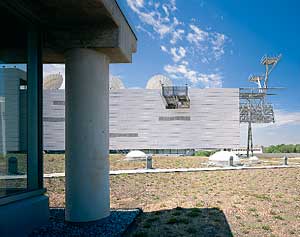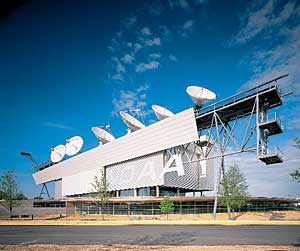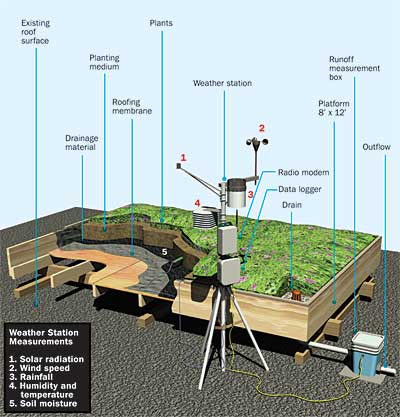Rooftops Slowly, but Steadily, Start to Sprout
The primarily permeable surfaces of NOAA's site slow the rate and quantity of runoff and help remove undesirable solids and nutrients from this water, according to Max Kantzer, an associate at A. Morton Thomas & Associates, the project's civil engineer. The site needed only minimal storm-water-management features, such as a small detention structure, and shallow grass-lined swales. "The green roof reduces the amount of storm-water management needed on-site, and contributes a significant amount of water-quality control," he says.
 |
| National Oceanic and Atmospheric Administration At NOAA's new satellite operations center (below and bottom) in Suitland, Maryland, a conventionally roofed, 70,000-square-foot building houses the satellite control equipment. But the bulk of the facility- a 140,00-square-foot office space-is built into a grassy slope. The site's primarily permeable surfaces provide almost all of the required storm-water quantity and quality management. Photography: © Maxwell Mackenzie |
 |
Another project under way in the region will have an even larger green roof. The Howard Hughes Medical Institute is building a research center in Loudoun County, Virginia, designed by Rafael Viñoly Architects (RVA). Clusters of offices and conference rooms are set into curved
terraces covered by a 180,000-square-foot green roof punctuated with interior courtyards. Support spaces not requiring natural light, such as a 300-car parking garage and a central plant, are also submerged under the green roof but are set away from the terraced edges.
| Click image for larger view |
| A Seattle research project is tracking both weather and runoff data at five green roof test plots (above). Rendering: Courtesy Magnusson Klemencic Associates |
The landscaped roof of the Howard Hughes facility will retain more storm water than a traditional lawn, and the runoff will not require extensive treatment to remove contaminants, due to its engineered drainage and planting media, says Jay Bargmann, AIA, RVA vice president. A built-up roof is considered to have a runoff coefficient of 0.95; in other words, about 95 percent of the water hitting a conventional roof will leave the surface and need to be accounted for in the design of the building's storm-water system. In comparison, a traditional lawn or turf area is considered to have a runoff coefficient of 0.35, while that of the Howard Hughes landscaped roof is 0.25. But Bargmann points to a less tangible benefit of the green roof as even more important. As he notes, "The project sets a standard for [preserving] open spaces in that suburban environment."
In the Pacific Northwest, a more modest size green roof is in the process of being installed on top of Michael Graves's Portland Building, completed in 1982. The 18,200-square-foot extensive installation, designed by Macdonald Environmental Planning, will include a variety of sedums and grasses, and was spawned by a city council resolution passed earlier this year. The regulation requires that new city buildings include a green roof, if practical, and also applies when roofs on existing buildings are replaced.
Â










